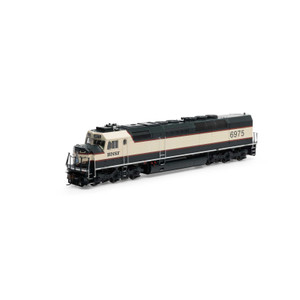
Athearn Genesis # ATHG64226 HO SDP40F Locomotive with DCC & Sound, BNSF #6975
Athearn Genesis
Athearn Genesis # ATHG64221 HO SDP40F Locomotive with DCC & Sound, EMD #268
EMD FEATURES:
Oscillating headlight
Functioning “Big Hole” Emergency light in (DCC Only)
Classification lights (Function in DCC only)
Number board lights
Working Truck lights
Separate see-through intake grills
MU hoses
Many of the Amtrak SDP40F’s were returned to EMD in trade for a new locomotive model, the F40PH. While many of them were scrapped, EMD retained a few for use as testbeds for future locomotive production. EMD 268 was one of these testbeds. Unofficially tagged as an “F50CM,” in 1988 the 268 was rebuilt using equipment produced by Siemens, so EMD could test current-source inverters and AC traction motors.
SDP40F SERIES LOCOMOTIVE FEATURES:
Illuminated ground lights
Illuminated classification lights
Illuminated number boards
Front and rear trainline hoses
Non-skid end walks
Front and rear 3-hose M.U. hose clusters with silver ends
Detailed and painted cab interior with control stand
4,500 gallon split fuel/water or rebuilt fuel only tank
HTC sideframes with high brake cylinders and air lines
Flush mounted portal window glass
Minimum radius: 18” — Recommended radius: 22”
GENESIS DIESEL LOCOMOTIVE FEATURES:
Coupler cut levers
MU hoses
Trainline hose
See-through cab windows
Full cab interior
Walkway tread
Windshield wipers
Wire grab irons
Sander lines
Lift rings
DCC-ready features Quick Plug™ plug-and-play technology with 21-pin NEM connector
Fine-scale Celcon handrails for scale appearance
Detailed fuel tank with fuel fillers, fuel gauges, breather pipes, and retention tanks
Body-mounted McHenry® operating scale knuckle couplers
Genesis driveline with 5-pole skew wound motor, precision machined flywheels, and multi-link drivetrain for trouble free operation
Eight-wheel drive with precision gears for smooth and quiet operation
All-wheel electrical pickup provides reliable current flow
Wheels with RP25 contours operate on all popular brands of track
LED Lighting for trouble free operation
Heavy die-cast frame for greater traction and more pulling power
Scaled from prototype resources including drawings, field measurements, photographs, and more
Accurately-painted and –printed paint schemes
Fully-assembled and ready-to-run
Packaging securely holds the model for safe storage
SOUND-EQUIPPED MODELS ALSO FEATURE
Onboard DCC decoder with SoundTraxx Tsunami2 sound
Dual sugar cube speakers for optimal sound quality
Sound units operate in both DC and DCC
Full DCC functions available when operated in DCC mode
Engine, horn, and bell sounds work in DC
All functions NMRA compatible in DCC mode
Precision slow speed control
Program a multiple unit (MU) lashup with lead unit only horn, bell, and lights
Many functions can be altered via Configuration Value (CV) changes
CV chart included in the box
PROTOTYPE SPECIFIC INFORMATION
Formed in 1971, Amtrak took over operation of most of America’s passenger trains with an assortment of old locomotives, primarily decades-old E-units. The carrier worked with General Motors Electro-Motive Division to design new passenger locomotives. The result was the SDP40F. Built by EMD from 1973–1974 for Amtrak and for a brief time they formed the backbone of Amtrak’s long-distance passenger fleet. With 150 built, the SDP40F became the “face” of Amtrak in the mid-1970s as they were found on the head ends of passenger trains from San Diego to Washington DC and from Seattle to Miami. Several were rebuilt and found a second life with the Atchison, Topeka and Santa Fe Railway in freight service.
The design of the SDP40F was based on the EMD FP45 passenger locomotive. Both shared the EMD 645E3 diesel engine, although the SDP40F had 16 cylinders instead of 20. The space saved from the smaller prime mover was given over to increased water capacity. The SDP40F had an underbody tank split between water and diesel fuel, carrying 2,000 gallons of water and 2,500 gallons of diesel. A second 1,500 gallon water tank sat in the carbody, forward of the steam generators which produced the steam needed for supplying heat (and sometimes cooling) and hot water for the train.
Eventually, the SDP40F was phased out as all-electric cars, such as the Amfleet, displaced the old steam heat rolling stock. While the SDP40F was designed with conversion to head-end power (HEP) in mind, the bad press they received, cost to upgrade and overhaul the units, and Amtrak’s satisfaction with the versatility of the HEP-equipped F40PH ultimately doomed the SDP40F. Amtrak was able to trade in the SDP40Fs to EMD as more F40PH units were acquired in the late 1970s. The last SDP40F was retired from Amtrak in the early 1980s.
In 1984, Santa Fe Railway traded lower-power locomotives to Amtrak for 18 SDP40Fs, horsepower-for-horsepower. The SDP40Fs were reconditioned in the railroad’s San Bernardino, California shops to the designation SDF40-2 for use as freight locomotives. Santa Fe replaced the hollow HTC bolsters with conventional HTC bolsters, converted the below-frame combination fuel/water tank to an all-fuel tank, removed the above-frame water tanks (replacing these with concrete ballast) and used the engines for nearly 15 years. They were also given front steps and platforms. Their noses were notched after a second maintenance shop visit in order to improve boarding access. In exchange, Amtrak received 43 smaller locomotives for use in switching service.